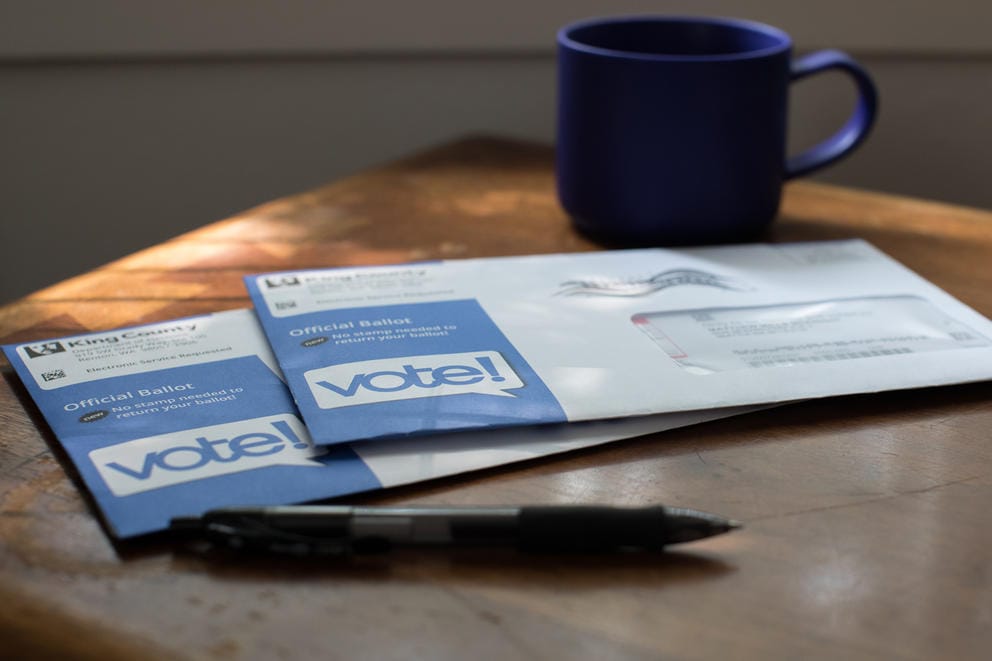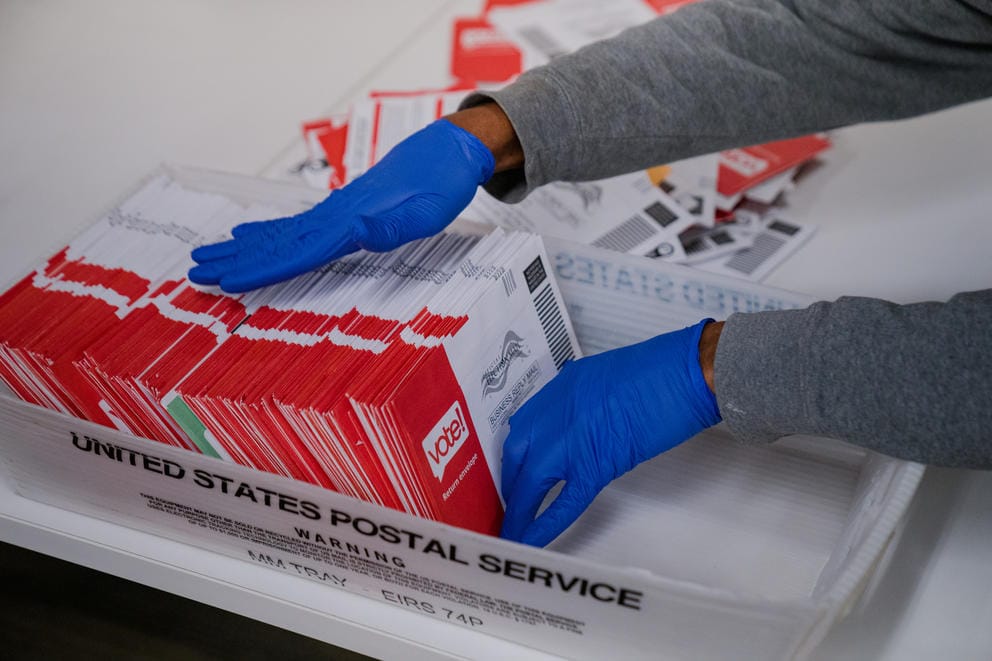In August, when Alaska Democrat Mary Peltola won a surprise victory over Sarah Palin and another Republican for a seat in Congress, it generated renewed discussion of ranked-choice voting, which allows voters to select multiple candidates on their ballots. Alaska voters adopted a version of this system in 2020, and now Seattle and two Washington counties are asking voters to consider ranked-choice voting on their November ballots.
The Alaska test of ranked-choice voting has produced a surprising – and some would say, desired – outcome.
Seattle, as well as Clark and San Juan counties, will be asked whether they want to change their election systems and allow voters to select more than one candidate in primary elections. In Seattle, the change would affect voting for the offices of mayor, city attorney and city council. But as is often the case in Seattle politics, it’s not a simple matter. On the November ballot, Seattle voters will be asked to choose between one of two approaches: ranked-choice or approval voting. Ranked-choice voting allows voters to rank each candidate on the ballot in numerical order of preference, while approval voting lets voters select as many candidates as they want, but assigns no rank to those selections.
Nearly 50 cities and counties in the U.S. currently allow voters to select or rank multiple candidates in elections, and two states – Alaska and Maine – use some version of ranked-choice for all elections. Lisa Ayrault, chair of FairVote Washington, says ranking candidates is simple and intuitive.
“Today, I went downstairs looking for breakfast,” she said. “I looked in the refrigerator hoping to find the last piece of chocolate cake. But somebody beat me to it, and so I had my second choice for breakfast. If we can’t have our first choice, we go for our backup. We know how to do that.”
This story was inspired by questions from our readers, including Katy Brown, Anna Rudd and Judith Alexander. Please share your questions with Crosscut and we will consider them for future stories. Ask us your questions here.
Advocates of voting reform claim that letting voters select multiple candidates helps eliminate the “spoiler effect”: when two candidates with similar positions lose to a third candidate that a majority of voters aren’t happy with. It’s also touted as giving voters more choices, increasing the diversity of candidates and reducing polarization.
Alan Durning, director of Sightline Institute, a Seattle-based think tank that’s been pushing ranked-choice voting for more than a decade, said that in general, the hundreds of ranked-choice elections held in the U.S. have tended to favor widely acceptable candidates with a strong base of support.
“The classic example seems to be either they’re centrists or they are very effective at building consensus and reaching out across the electorate,” Durning said.
That’s essentially what happened in Alaska: A centrist Democrat was able to convince enough supporters of Republican Max Begich that the third alternative, Sarah Palin, was too extreme, then succeeded in convincing enough Begich voters to select Peltola as their second choice.
Ayrault of FairVote says that city councils also often become more diverse after instituting ranked-choice systems.
“Is there data on ranked-choice voting showing it makes a real difference in women's representation and the representation of people of color? Absolutely,” she said. She notes that after New York City put in place ranked-choice, the number of women on the 51-seat city council went from 14 to 31 – and 26 of those were women of color.
Political consultant Sandeep Kaushik, however, is skeptical. He notes that Seattle’s city council and mayor’s office are currently well-represented by women and minorities. “I don’t see a problem with our municipal election system,” Kaushik said. “I don't understand what the intent here is, other than some wishful thinking: that by changing the structure of our elections, we can put our fingers on the scale and alter results we’re unhappy with.”
Seattle’s Initiative 134 earned a spot on the ballot after the organization Seattle Approves succeeded in gathering 43,000 signatures over the spring. In contrast to ranked-choice voting, the approval voting system that Seattle Approves put forward lets voters select as many candidates on the ballot as they want without ranking their preferences.
Seattle Approves chair Logan Bowers believes this approach is preferable to ranked-choice. “If we're going to do reform,” Bowers said, “we should do the one that’s the most representative, the most equitable and the simplest.”
However, in July on a 7-2 vote, the city council passed a measure that added a second alternative to I-134: ranked-choice.
So voters will need to make two decisions regarding I-134: first, whether they want to change Seattle’s primary system from its current top-two format – the current statewide approach – to some sort of multiple-choice ballot. Second, voters need to select which multiple-choice approach they prefer, ranked-choice or approval voting. Whether one votes yes or no on the first question, a voter can still weigh in on which system they prefer in the second question.
Kaushik believes the current system in Seattle works just fine. “The whole point of the primary system is to create a clear general-election choice,” he said. “And I think our top-two system does that very well,” he said.
For those who would rather vote for multiple candidates, here’s a closer look at the two proposals:

Ballots ready to be mailed. (Matt McKnight/Crosscut)
Proposition 1A: approval voting
The first option, approval voting, is relatively simple: Instead of choosing one candidate, Seattle primary voters in municipal elections would be allowed to select as many candidates as they like. The two candidates who receive the most votes advance to the general election.
Unlike ranked-choice, approval voting is relatively rare. Fargo, North Dakota, and St. Louis are the only U.S. cities that currently use approval voting. However, Bowers, the chair of Seattle Approves, says the election of Tishaura Jones as the first Black woman mayor of St. Louis in 2021 demonstrates how approval voting can diversify a pool of candidates. “In the previous election, she got 30% of the vote because it was split,” he said. “In 2021 she got 57%. So it was clearly night and day.”
Ayrault, the director of FairVote, says she has concerns that approval voting can lead to a prevalence of “bullet voting” – in which many voters still only vote for one candidate even though they’re allowed to vote for more than one. “If they want their first choice to win,” she said, “often the best strategy for the voter is to just pick one.”
Bowers counters that there’s not a lot of evidence that this happens. In Fargo’s most recent election, he says voters marked an average of 1.5 candidates on their ballots. “So you can imagine, in a Seattle 15-way race, you might get an average of between two or three.”
Durning points out that ranked-choice voting has a much more established track record, with 500 elections to study versus three – making the practical implications of approval voting relatively unknown. “I like to think of approval voting like a promising new drug that’s in clinical trials,” he said. In a post at Sightline from August, Durning suggested that approval voting might be subject to legal challenges, but he conceded in an interview that those risks were “small.”
EJ Juárez, a DEI professional who has worked on electoral and social-equity issues across Washington state for over a decade, has concerns that approval voting won’t increase equity for people of color. He faults Seattle Approves for not consulting communities of color that have been advocating locally for ranked-choice for many years.
“Electoral reform should be built from the foundation of how we improve participation and access for people with the least access today,” he said. “Any time an effort to change the rules of the game is almost completely funded by out-of-state interests with virtually no local supporters, my spidey senses go off,” he said.
Seattle Approves has received $211,000 – or 40% of its funding – from The Center for Election Science, a California-based nonprofit that advocates for approval voting. Cryptocurrency entrepreneur Sam Bankman-Fried, who lives in the Bahamas, contributed $135,000, while Jeff Justice, a retired software engineer in Palo Alto who’s a board member of The Center for Election Science, contributed $20,000. The remaining $128,000 came from 90 individual donors.
The other campaigns have raised much less. Seattle for Election Simplicity, which supports keeping the current system, has raised $43,000 from 16 individual donors, and Ranked Choice Voting for Seattle has received $51,900 from 59 individual donors.
Bowers insists that even if approval voting is relatively untested, it’s the only system that actively discourages strategic voting: “It makes sure that voters are honest about who they like, and they get to vote for who they truly like without worrying about splitting their vote or throwing their vote away,” he said.

Temporary election workers process ballots at the King County Elections headquarters in Renton on Tuesday, Nov. 2, 2021. (Jovelle Tamayo/Crosscut)
Proposition 1B: ranked-choice voting
The second option on the ballot is ranked-choice voting. In this system, Seattle primary voters can rank their choices in order of preference. When votes are counted, the candidate with the fewest number of top-ranked votes is eliminated. That candidate’s second-choice votes would then be re-assigned to those candidates, and after arriving at new totals, the candidate with the fewest votes would be eliminated. This tallying process continues until two candidates remain. Those two candidates would face each other in the general election.
The use of ranked-choice in a primary is unusual. Most ranked-choice systems do away with primaries altogether, but because of Washington state law, few local jurisdictions can eliminate the primary and put in place ranked-choice for the general election.
Durning of Sightline Institute notes that because of a loophole in state law, there is one exception: “charter counties” that elect both a council and county executive. Two such counties, Clark and San Juan, have initiatives on the ballot this November that would amend their county charters to do away with primaries altogether and put in place a ranked-choice system for general elections.
Shasti Conrad, chair of the King County Democrats, says the local party committee voted in August to endorse reforming Seattle’s system via I-134 and to support the switch to ranked-choice voting. “It would give people a better opportunity to fully participate and not just have to choose the lesser evil,” she said.
Bowers thinks, however, that adding ranked-choice to the existing primary structure would result in a more complicated system than approval voting. “Studies have found that a complex ballot, like a ranked ballot, can lose anywhere from 2% to 8% of voters,” he said. “We don’t want to disenfranchise any voters in the process.”
Ayrault disagrees, noting that in exit surveys after a recent New York City election, 95% of voters found the ranked-choice ballot simple to understand, and 85% of Alaska voters said the same thing. “Ranked-choice voting works, and we know it,” she said. “And approval voting is making a lot of claims that they can’t back up.”
Ranked-choice voting has an array of endorsements, including the League of Women Voters Seattle-King County, the Transit Riders Union, Northwest Progressive Institute, Puget Sound Sage and Entre Hermanos. Juárez says that’s important.
“Any proposal to change election rules must have diverse and broad local support, increase representation of previously underrepresented communities, and boost participation,” he said. “Ranked-choice voting has a proven record of boosting all three, regardless of ideology, and has been supported by diverse communities and interests across the state.”



